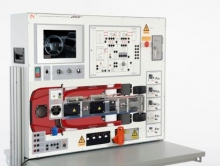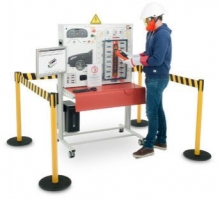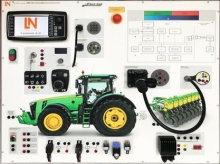ASE L3 Trainer Light Duty Hybrid/Electric Vehicle Specialist
Lucas-Nuelle's Hybrid/Electric vehicle trainer encompasses all facets of the ASE L3 test by merging a comprehensive curriculum with hands-on practical tasks, ensuring students acquire the competencies and profound system understanding essential for success in this technologically advanced market. Empower your students to bolster their confidence as they engage with a cutting-edge real-world system, gaining the expertise necessary to handle procedures for hybrid/electric vehicles securely.
In the USA, approximately 4 million hybrid and electric vehicles have already been sold, and sales are rapidly escalating. As the demand for novel technology and intricate vehicles grows, it's imperative that both current and future technicians are equipped to tackle the challenges involved in diagnosing and repairing these vehicles.
As part of SkillsUSA's automotive challenges, this trainer stands as a pivotal component. Here, students are tasked with showcasing their diagnostic skills and knowledge concerning hybrid and electric vehicles. Aligned meticulously with the ASE L3 curriculum, our trainer provides a comprehensive platform for students to demonstrate their proficiency in this ever-evolving automotive realm.
Changeable Overlay Masks
Teach 5 different drive types on one trainer by changing the overlay.
- Parallel hybrid
- Fuel-cell vehicle
- Electric vehicle
- Series-parelle. hybrid
- Series hybrid
Benefits
- Use real HV measurement devices
- Fault simulations
- Real charging function
- Highest safety standards built into trainer to create a safe learning environment
- Learn and understand how to perform HV system shutdown
- Occupational safety is an essential component of the training
- And more!
Key Features
(Click to enlarge)
Topics and Hands-On Practical Tasks Covered
Allow your students to build confidence by knowing they can safely work on a state-of-the-art real-world system that performs the procedures needed on hybrid/electric vehicles.
Topics included in the curriculum
- Multiple types and operation of hybrid and electric vehicles
- Motor/generator operation with experiments and animations
- Battery management systems
- Drive systems
- Power electronics including inverters, DC to AC conversion and
- Safe handling of HV systems
- Internal combustion engines
- Instructor Fault Insertion included for troubleshooting the system
Practical tasks and experiments include:
- Isolation procedure and voltage measurement
- Measurements of real high voltage to understand electric motors
- Fault finding and diagnostics with real-world faults such as insulation resistance measurement
- Resolver/motor positioner
- Energy flows in series, parallel, series-parallel, fuel cell and pure electric vehicles
- High voltage capacitors found in EVs
- Charging connections
- Integration of Tasks can even be done on existing vehicles if available

Frequently Asked Questions
(Click to learn the answer)
Why is this HEV/EV Trainer your best choice? Isn’t a “real” electric car a better way to learn? Why should I include HEV/EV in my program? What instruction areas does the LN HEV/EV Trainer address?Why is this HEV/EV Trainer your best choice?
- ASE L3 Certified - no other trainer is!
- Career Readiness: : Students learn to diagnose and resolve real-world faults in (1) hybrid, (2) electric, and (3) fuel cell vehicles!
- Student Safety: Students learn the proper procedures for SAFELY working on high voltage HEV/EV and fuel cell vehicles using low amperage which means that in no way can it cause any harm to students.
- It's all REAL! But SAFE. There is no way the equipment can hurt the student, or the student can hurt the equipment!
- Real voltages (300V) - but only milliamps for safety!
- Real three-phase inverter
- Real electric motors/generators
- Real resolver
- Real charging socket
- Real fault test procedures
- Real orange HV cables
- Real diagnostic tester
- You get the idea! No simulations.
- Complete ASE L3 aligned e-Learning curriculum with individual animations for each of the five drive trains, videos, and over 40 hands-on tasks! Never any subscription fees. Installs locally, on the intranet, or even on an LMS.
- Students learn the most important task of the complete shutdown process using a real HV service plug, 12V battery terminals, HV measuring points, and even a real car key.
- Students safely record real industry measurements using virtual measurement equipment (oscilloscope, ammeter, etc.) within the curriculum that easily connects via USB or Wi-Fi to the trainer. No expensive additional equipment is needed!
Isn't a "real" electric car a better way to learn?
Definitely NOT!
The #1 reason is SAFETY. The LN HEV/EV trainer allows students to gain confidence conducting real fault-finding training without putting themselves and others at risk from a high-voltage system. Once properly trained, your students will be able to confidently work safely on hybrid, electric, and fuel cell vehicles!
Another reason is that this trainer is flexible and designed to be used repeatedly without breaking down/setting-up equipment. Real vehicles, and even some other EV trainers, require lots of manual prep work. You would also be required to manipulate the system in order to put faults into it, risking total failure of the system and even thermal runaway of a cell in the HV battery.
Why should I include HEV/EV in my program?
Electric vehicles may not be in your future, but they WILL be in your students'! With over 10 million electric cars on the world's roads and growing, auto tech programs would be doing a disservice if they allowed students to leave their program without HEV/EV training.
What instruction areas does the LN HEV/EV Trainer address?
- Multiple types and operation of hybrid and electric vehicles
- Motor/generator operation with experiments and animations
- Battery management systems
- Drive systems
- Power electronics including inverters, DC to AC conversion and safe handling of HV systems
- Operating principle for interlock contacts
- Instructor Fault Insertion for trouble-shooting the system including traction battery, inverter, motor/generator, insulation, shielding of HV cables and equipotential bonding.























